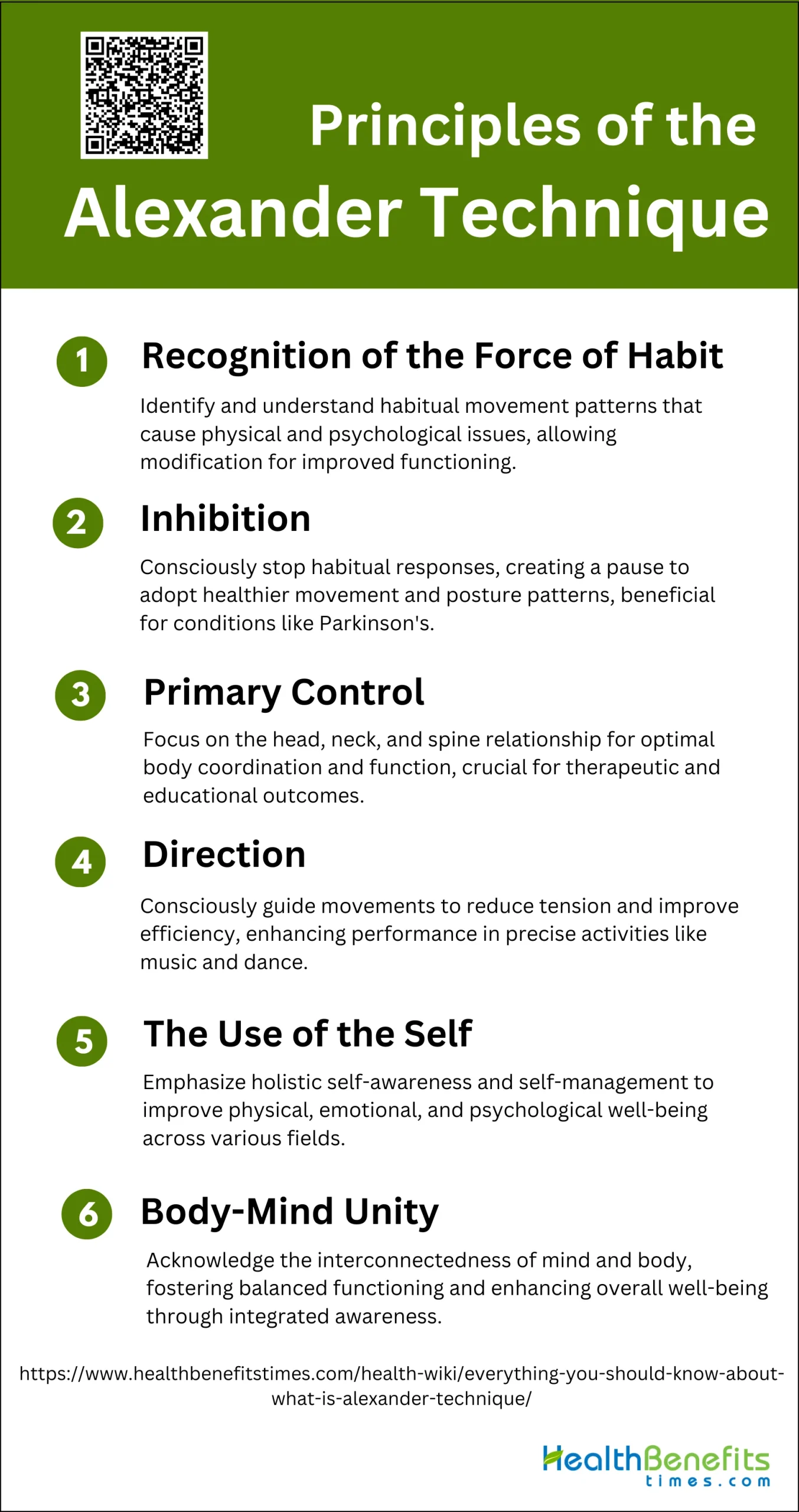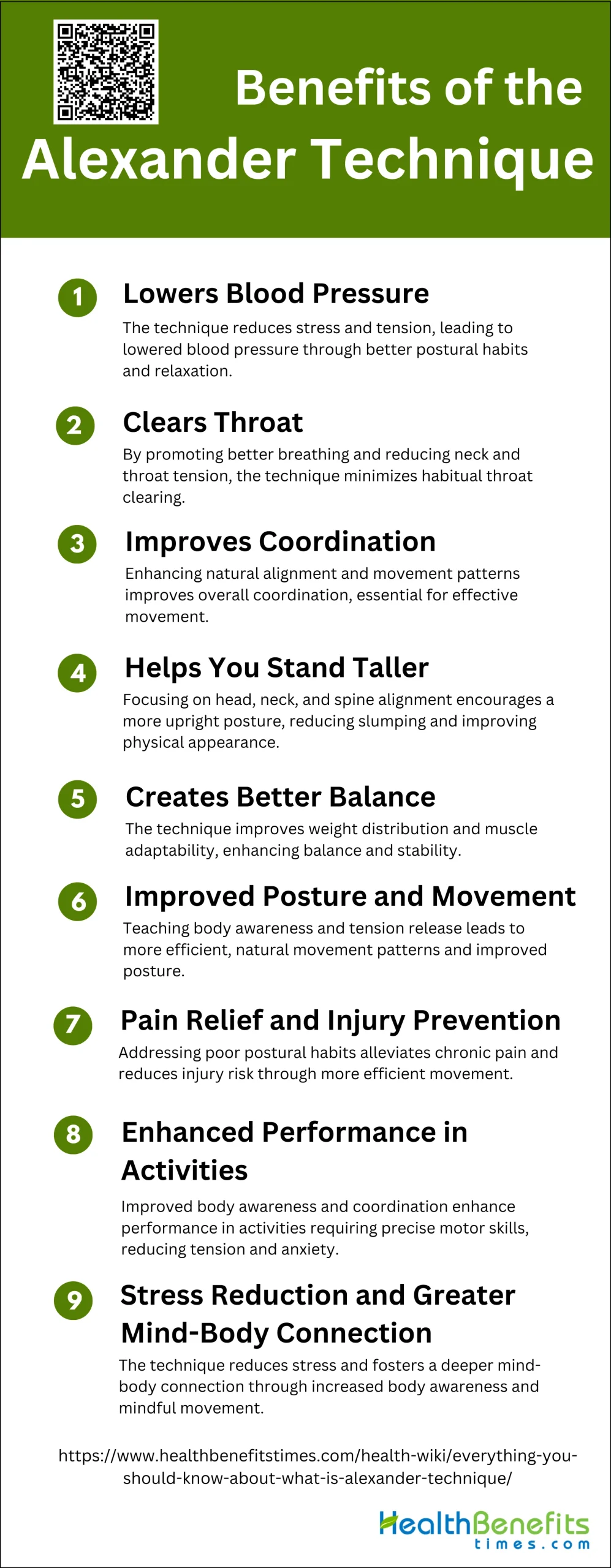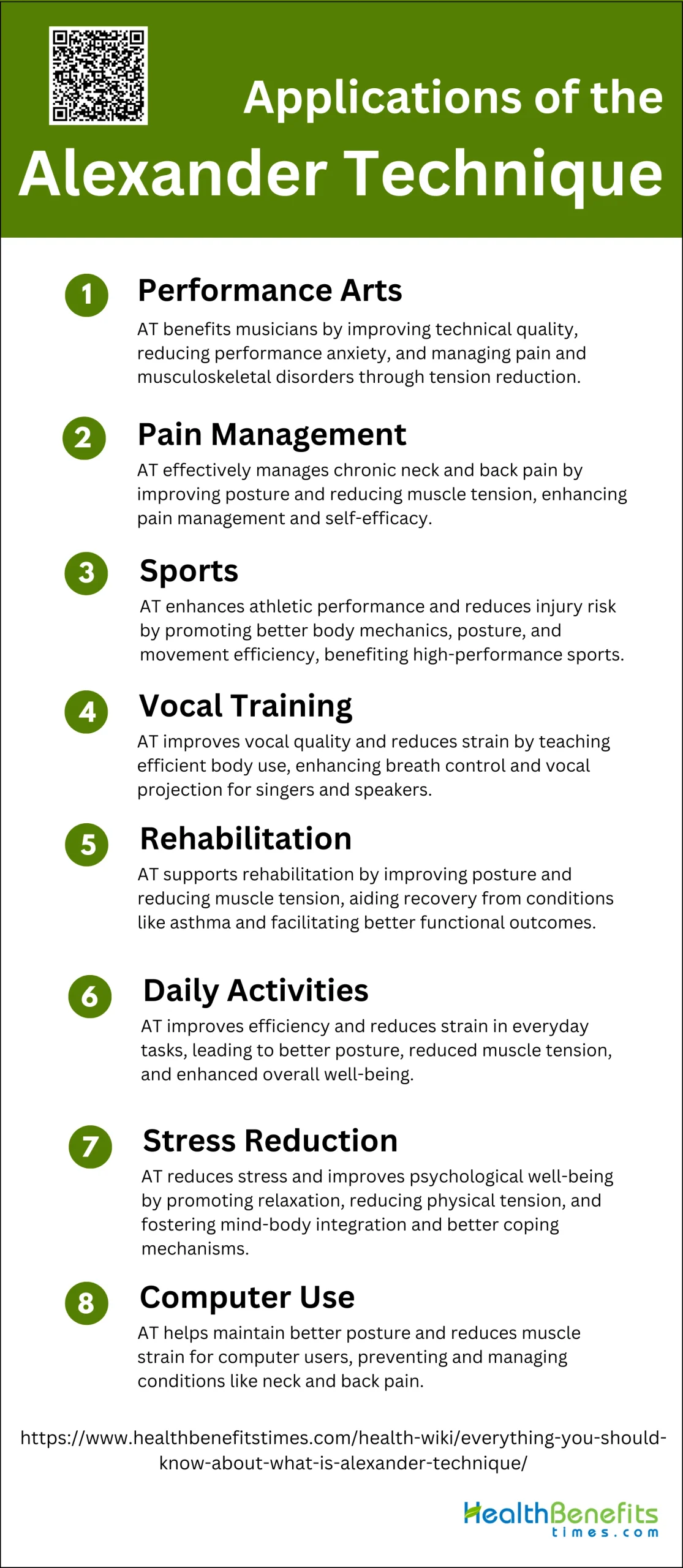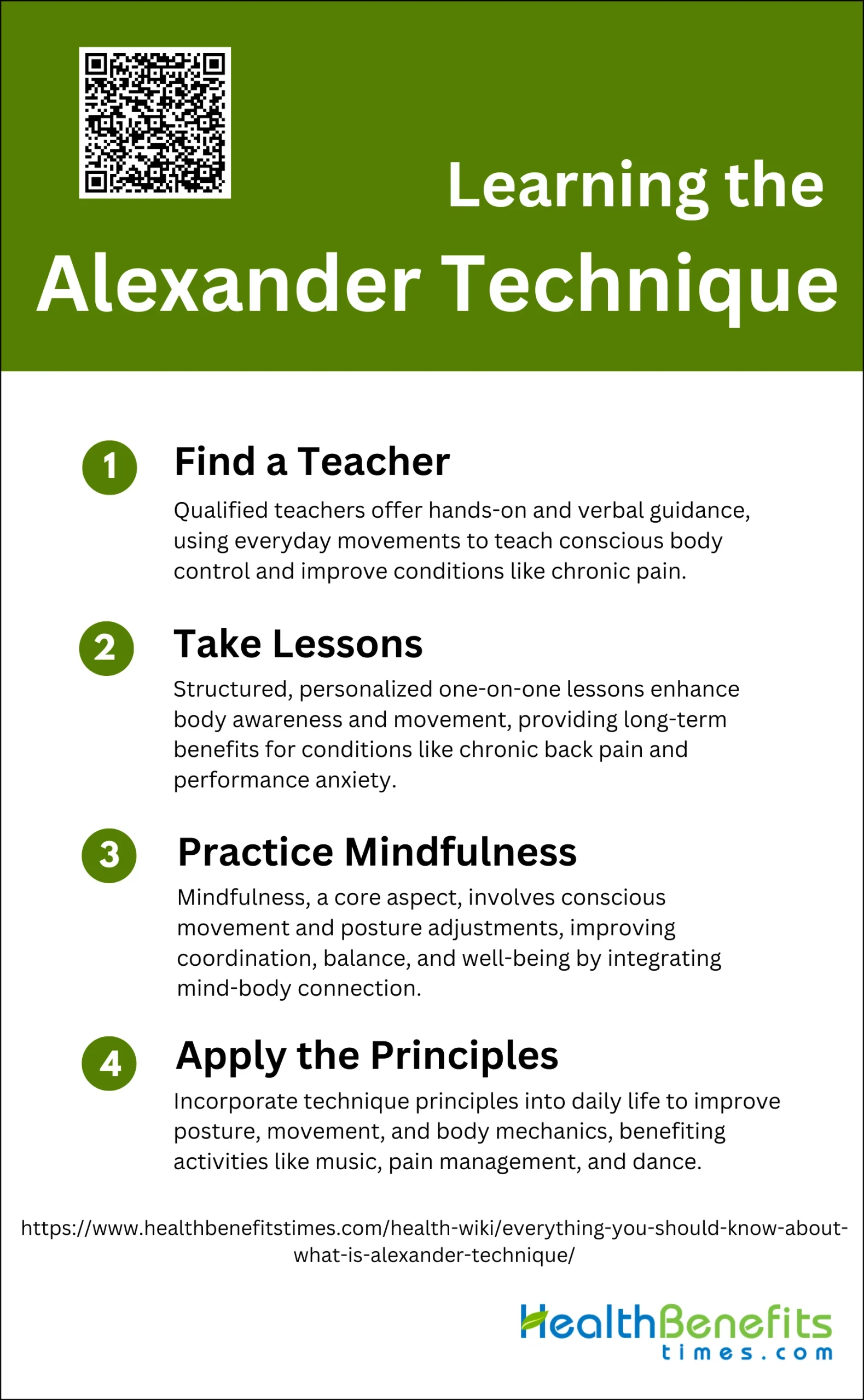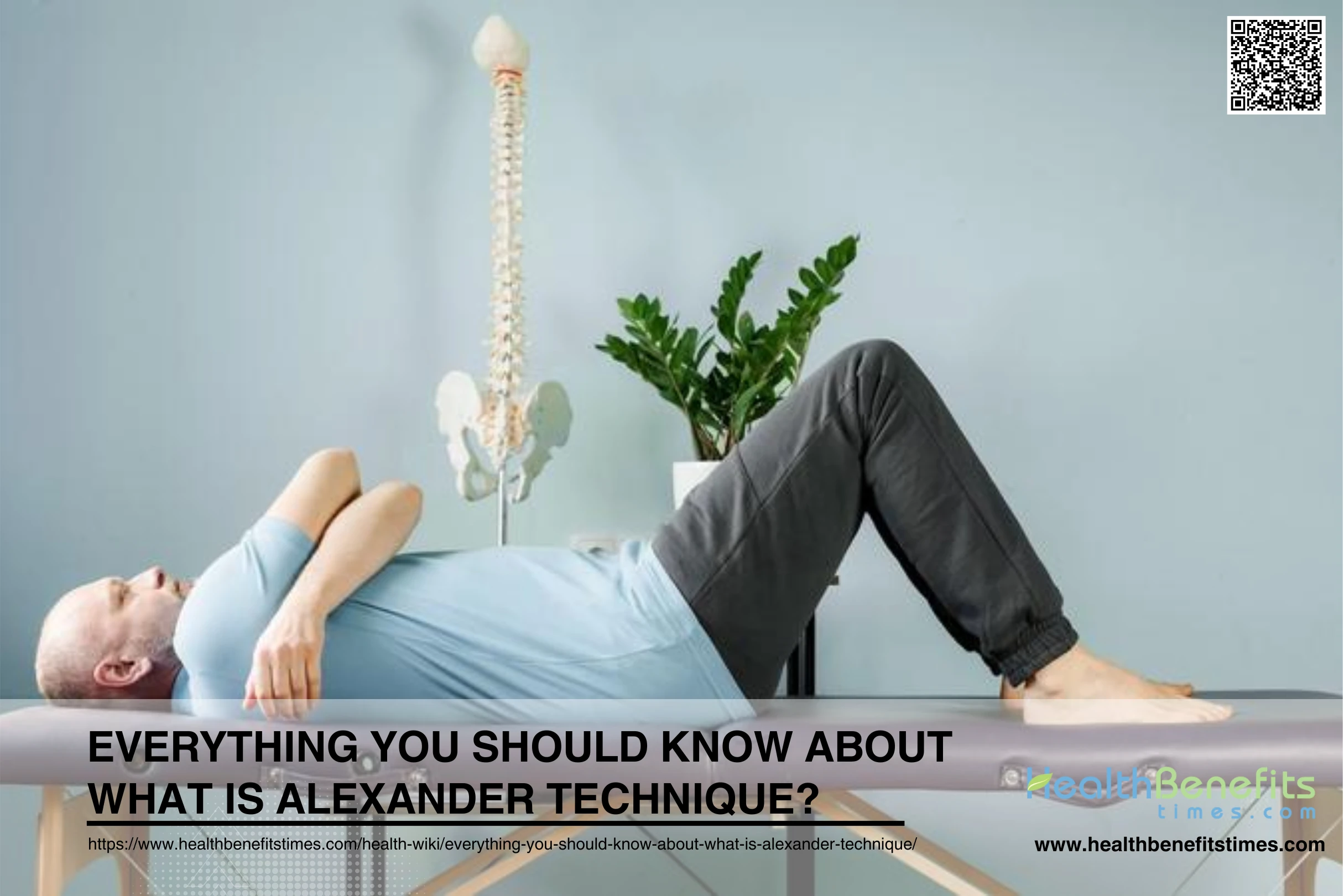 The Alexander Technique is an educational method developed by Frederick Matthias Alexander in the late 19th century, focusing on improving posture and movement to alleviate pain and enhance overall well-being. It involves learning to recognize and change habitual patterns of tension and poor posture through guided instruction, often involving subtle hands-on guidance from a certified teacher. The technique emphasizes the mind-body connection, aiming to promote better coordination, balance, and ease of movement. It has been shown to be effective in reducing chronic pain, particularly in the neck and back, and is used by individuals ranging from performing artists to those seeking relief from musculoskeletal issues.
The Alexander Technique is an educational method developed by Frederick Matthias Alexander in the late 19th century, focusing on improving posture and movement to alleviate pain and enhance overall well-being. It involves learning to recognize and change habitual patterns of tension and poor posture through guided instruction, often involving subtle hands-on guidance from a certified teacher. The technique emphasizes the mind-body connection, aiming to promote better coordination, balance, and ease of movement. It has been shown to be effective in reducing chronic pain, particularly in the neck and back, and is used by individuals ranging from performing artists to those seeking relief from musculoskeletal issues.
Principles of the Alexander Technique
The Alexander Technique is based on several core principles that aim to improve posture, movement, and overall well-being by addressing habitual patterns of tension and poor posture. Here are the key principles:
1. Recognition of the Force of Habit
The Alexander Technique emphasizes the importance of recognizing and understanding habitual patterns of movement and posture that may be physiologically unfavorable. These habits often operate subconsciously and can lead to various physical and psychological issues. By becoming aware of these ingrained habits, individuals can begin to modify them, leading to improved overall functioning. This recognition is crucial for addressing issues such as stuttering, where habitual muscle tension plays a significant role.
2. Inhibition
Inhibition in the context of the Alexander Technique refers to the conscious decision to stop or prevent habitual responses. This principle is about creating a pause before reacting, allowing for a more mindful and controlled response. Inhibition helps in breaking the cycle of automatic reactions and is essential for retraining the body and mind to adopt healthier patterns of movement and posture. This approach has been shown to be beneficial in managing conditions like Parkinson’s disease, where habitual movements can exacerbate symptoms.
3. Primary Control
Primary control is the concept that the relationship between the head, neck, and spine is fundamental to the overall coordination and functioning of the body. Maintaining a balanced and free relationship in this area is crucial for optimal movement and posture. The Alexander Technique teaches individuals to become aware of and improve this primary control, which can lead to better physical and psychological outcomes. This principle is central to the technique’s effectiveness in various therapeutic and educational settings.
4. Direction
Direction involves the conscious guidance of the body’s movements. It is about thinking in a way that encourages the body to move in a coordinated and efficient manner. This principle helps individuals to use their bodies more effectively, reducing unnecessary tension and improving overall function. Direction is particularly useful in activities that require precise and controlled movements, such as playing a musical instrument or performing dance routines.
5. The Use of the Self
The use of the self refers to the holistic approach of the Alexander Technique, which considers the mind and body as a unified entity. This principle emphasizes the importance of self-awareness and self-management in achieving better health and performance. By learning to use one self-more effectively, individuals can improve their physical, emotional, and psychological well-being. This concept is fundamental to the technique’s application in various fields, including education, healthcare, and the arts.
6. Body-Mind Unity
Body-mind unity is the foundational principle of the Alexander Technique, which posits that the mind and body are not separate entities but are interconnected and influence each other. This holistic view is essential for understanding how mental states can affect physical posture and vice versa. By fostering a greater awareness of this unity, individuals can achieve a more balanced and integrated way of functioning. This principle is supported by evidence showing that improvements in physical well-being can lead to enhanced psychological well-being.
Benefits of the Alexander Technique
By teaching individuals to unlearn habitual patterns of tension, this method offers a range of benefits that enhance both physical and mental health. Below is a list of the key advantages that come with practicing the Alexander Technique.
1. Lowers Blood Pressure
The Alexander Technique (AT) has been shown to help individuals manage stress and improve overall relaxation, which can contribute to lowering blood pressure. By teaching individuals how to release unnecessary tension and adopt more efficient postural habits, AT can reduce the physiological stress responses that often lead to elevated blood pressure. For instance, a study on chronic neck pain demonstrated that AT lessons led to significant reductions in pain and stress, which are closely linked to blood pressure levels. Additionally, the technique’s emphasis on mindful movement and relaxation can help mitigate the effects of chronic stress, further supporting cardiovascular health.
2. Clears Throat
The Alexander Technique can aid in clearing the throat by promoting better breathing and reducing unnecessary tension in the neck and throat muscles. This is particularly beneficial for individuals who experience habitual throat clearing due to stress or poor posture. By learning to align the body properly and use the respiratory system more efficiently, individuals can reduce the strain on their vocal cords and throat. Studies have shown that AT can improve overall posture and muscle coordination, which indirectly supports better respiratory function and reduces the need for throat clearing.
3. Improves Coordination
Improving coordination is one of the core benefits of the Alexander Technique. The technique focuses on enhancing the body’s natural alignment and movement patterns, which can lead to better overall coordination. Research has shown that AT lessons can significantly improve postural coordination and balance, which are essential components of effective movement. For example, a study involving individuals with low back pain found that AT lessons led to improvements in automatic postural responses and balance, highlighting the technique’s potential to enhance coordination.
4. Helps You Stand Taller
By focusing on the alignment of the head, neck, and spine, AT helps to reduce habitual slumping and encourages a more upright stance. This not only improves physical appearance but also contributes to better overall health. A pilot study on surgical ergonomics found that AT training significantly improved posture, allowing participants to stand taller and move with greater ease. This improvement in posture can also lead to reduced strain on the body and enhanced physical performance.
5. Creates Better Balance
Better balance is a key benefit of the Alexander Technique, as it teaches individuals to distribute their weight more evenly and use their bodies more efficiently. This can be particularly beneficial for activities that require precise balance and coordination. Research has demonstrated that AT can improve balance by enhancing postural muscle tone and adaptability. For instance, a study on chronic neck pain found that AT lessons led to significant improvements in balance and postural coordination, which are crucial for maintaining stability during movement. These findings suggest that AT can be an effective tool for improving balance and preventing falls.
6. Improved Posture and Movement
The Alexander Technique is widely recognized for its ability to improve posture and movement. By teaching individuals to become more aware of their body mechanics and to release unnecessary tension, AT promotes more efficient and natural movement patterns. Studies have shown that AT can lead to significant improvements in posture, which in turn enhances overall movement quality. For example, a study on the impact of AT on surgical ergonomics found that participants experienced improved posture and reduced strain during minimally invasive surgery, highlighting the technique’s potential to enhance movement efficiency.
7. Pain Relief and Injury Prevention
Pain relief and injury prevention are among the most well-documented benefits of the Alexander Technique. By addressing poor postural habits and teaching individuals how to move more efficiently, AT can help alleviate chronic pain and reduce the risk of injury. Research has shown that AT lessons can lead to significant reductions in pain and disability for individuals with chronic back and neck pain. For instance, a randomized controlled trial found that AT lessons resulted in long-term reductions in pain and improved quality of life for patients with chronic back pain. These findings suggest that AT can be an effective intervention for managing pain and preventing injuries.
8. Enhanced Performance in Activities
This is particularly beneficial for activities that require precise motor skills, such as playing a musical instrument or performing athletic movements. Research has shown that AT can improve performance by reducing habitual tension and enhancing overall coordination. For example, a study on music performance found that AT lessons led to improvements in technical quality and reduced performance anxiety, highlighting the technique’s potential to enhance performance in high-stress situations. These benefits can translate to improved performance in a wide range of activities.
9. Stress Reduction and Greater Mind-Body Connection
Stress reduction and a greater mind-body connection are central to the Alexander Technique. By teaching individuals to become more aware of their body and movement patterns, AT helps to reduce stress and promote a sense of well-being. Research has shown that AT can lead to significant reductions in stress and improvements in self-efficacy. For instance, a study on chronic neck pain found that AT lessons led to reduced neck pain and improved self-efficacy, suggesting that the technique can help individuals manage stress more effectively. Additionally, the emphasis on mindful movement and relaxation in AT fosters a deeper connection between the mind and body, contributing to overall mental and physical health.
Applications of the Alexander Technique
By teaching individuals how to realign their posture and movements, it fosters a sense of balance and ease that can enhance performance and well-being. Here are some key applications of this profound technique:
1. Performance Arts
The Alexander Technique (AT) has been shown to significantly benefit musicians by improving their performance quality and reducing performance anxiety. Studies have demonstrated that music students who received AT lessons exhibited enhanced technical quality and overall music performance, particularly in low-stress situations. Additionally, AT has been found to help musicians manage playing-related pain and musculoskeletal disorders, which are common occupational hazards in this field. The technique’s focus on reducing unnecessary muscle tension and re-educating movement patterns contributes to these improvements.
2. Pain Management
AT has been effectively used for managing chronic pain conditions, such as neck and back pain. Research indicates that individuals with chronic neck pain who participated in AT lessons experienced significant pain reduction and improved self-efficacy in managing their condition. Similarly, AT has been shown to be beneficial for chronic low back pain, with patients reporting better pain management and fewer obstacles to practicing the technique compared to other interventions like exercise. These benefits are attributed to the technique’s emphasis on improving posture and reducing habitual muscle tension.
3. Sports
In sports, AT can enhance performance by promoting better body mechanics and reducing the risk of injury. Although specific studies on athletes are limited, the principles of AT, such as improving posture and movement efficiency, are applicable to sports activities. By learning to move with less tension and more coordination, athletes can potentially improve their performance and reduce the likelihood of sports-related injuries. The technique’s focus on kinaesthetic awareness and intentional inhibition of non-beneficial movement patterns can be particularly beneficial in high-performance sports settings.
4. Vocal Training
AT is widely used in vocal training to help singers and speakers improve their vocal quality and reduce strain. The technique teaches individuals to use their bodies more efficiently, which can lead to better breath control and vocal projection. Case studies have shown that AT can help vocalists achieve a more relaxed and natural posture, thereby enhancing their tone quality and overall vocal performance. By addressing physical and mental tensions, AT enables vocalists to perform with greater ease and less effort.
5. Rehabilitation
AT is also applied in rehabilitation settings to aid recovery from various physical conditions. For example, it has been used to help individuals with chronic asthma improve their breathing efficiency and overall respiratory function. Although more robust studies are needed, preliminary evidence suggests that AT can support rehabilitation by promoting better posture and reducing muscle tension, which can facilitate the healing process and improve functional outcomes. The technique’s holistic approach to body use makes it a valuable tool in rehabilitation programs.
6. Daily Activities
AT can be beneficial in everyday activities by teaching individuals to move more efficiently and with less strain. This can lead to improved posture, reduced muscle tension, and a greater sense of well-being. Studies have shown that individuals who practice AT report better management of daily tasks and reduced pain associated with routine activities. The technique’s emphasis on mindful movement and body awareness helps individuals apply these principles to various aspects of their daily lives, enhancing their overall quality of life.
7. Stress Reduction
AT has been found to be effective in reducing stress and improving psychological well-being. By promoting relaxation and reducing physical tension, the technique can help individuals manage stress more effectively. Research indicates that AT can lead to improved general well-being, increased confidence, and better coping mechanisms for dealing with stress. The mind-body integration fostered by AT allows individuals to apply these skills to non-physical situations, contributing to long-term psychological benefits.
8. Computer Use
AT can help individuals who spend long hours using computers by teaching them to maintain better posture and reduce muscle strain. This is particularly relevant in preventing and managing conditions like neck and back pain, which are common among computer users. Studies have shown that AT can lead to more upright posture and reduced muscle fatigue during activities that involve prolonged sitting and computer use. By incorporating AT principles, individuals can improve their ergonomic practices and reduce the risk of developing musculoskeletal issues related to computer use.
Learning the Alexander Technique
Embarking on the journey of learning the Alexander Technique opens up a world of self-discovery and improved body awareness. This method teaches individuals how to release harmful tension and move with ease and balance. Below is a list of fundamental principles that guide students through the transformative process of the Alexander Technique.
1. Find a Teacher
Finding a qualified Alexander Technique teacher is crucial for effective learning. Certified teachers provide hands-on and spoken guidance, helping students understand the principles of the technique through experiential learning. This method is particularly beneficial as it involves direct communication through touch, which is a powerful tool in teaching conscious control over one’s body. Teachers often use everyday movements such as walking and standing to illustrate the technique, making it accessible and practical for daily life. The importance of a skilled teacher is underscored by studies showing significant improvements in conditions like Parkinson’s disease and chronic back pain when lessons are administered by certified professionals.
2. Take Lessons
Taking lessons in the Alexander Technique involves a structured approach to learning about body awareness and movement. Typically, lessons are conducted one-on-one, allowing for personalized instruction tailored to the individual’s needs. Research has shown that a series of lessons can lead to long-term benefits, such as reduced disability and pain in chronic conditions. For instance, a study on chronic back pain demonstrated that 24 lessons significantly reduced pain and improved quality of life. Similarly, lessons have been shown to improve performance and reduce anxiety in musicians, highlighting the technique’s broad applicability.
3. Practice Mindfulness
Mindfulness is a core component of the Alexander Technique, emphasizing the mind-body connection. Practicing mindfulness involves being aware of one’s movements and posture, and making conscious adjustments to improve efficiency and reduce tension. This approach has been shown to benefit various populations, including those with musculoskeletal conditions and musicians. By integrating mindfulness into daily activities, individuals can achieve better coordination, balance, and overall well-being. The technique encourages a holistic view of learning, where emotional, psychological, and physiological aspects are interconnected.
4. Apply the Principles
Applying the principles of the Alexander Technique involves incorporating its teachings into everyday life. This means using the learned skills to improve posture, movement, and overall body mechanics in various activities. For example, musicians can use the technique to alleviate tension and enhance performance, while individuals with chronic pain can apply it to manage their symptoms more effectively. The principles can also be integrated into other disciplines, such as dance, to facilitate a more coordinated and efficient use of the body. The ultimate goal is to achieve a state of ease and natural alignment, promoting better function and health.


